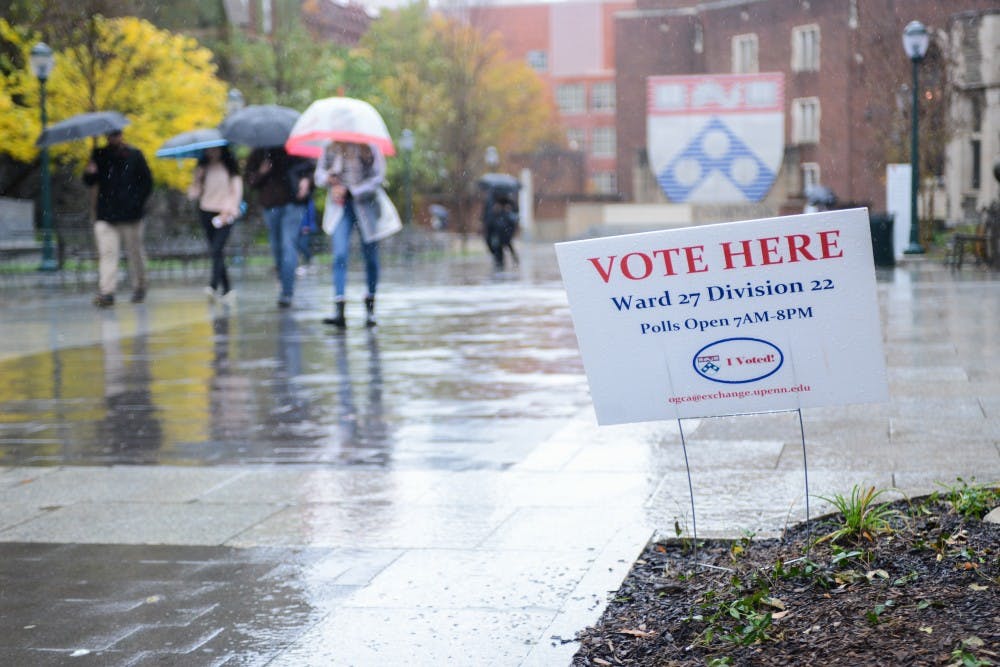
PENN REACTS TO 2018 MIDTERMS
The day after President Trump took the Oath of Office in front of a crowd of either 200 or 2 million people — the truth got lost somewhere along the way — I boarded a crowded bus to Washington to march amid the surge of pink hats. Trekking through the capital, I pretended to know exactly what I was marching for, to assemble a list of policy goals or at least some elegant notion of feminism as a rallying cry. But since I never actually had to draft a concrete ideology, it was enough just to ride the wave of fear and anger that engulfed our country.
And it really was anger that surrounded me. An inflatable plastic dummy bearing our rookie president’s face passed through the crowd in front of the Trump International Hotel. I remember wondering who this crude message was for. No one in the crowd that day seemed ready to write a love letter to the president, so what were they trying to prove?
Even a protest with the inclusive name “Women’s March” was partially split into groups with competing agendas. Clustered along the National Mall, Planned Parenthood protesters chanted very different cries from the strictly anti-Trump crowd. At the height of feminist unity, divisions persisted.
Tonight, election results popped onto the screen after the pulsing countdown of the clock. The cable news reporting of the midterm election felt a bit like New Year’s Eve, a sports game, and anything but a judgement on the fate of democracy. Hopes of finding clarity from the red or blue on the TV screen were desperately misplaced, as no triumphant victory or tragic defeat emerged for either party, no matter how Trump tries to spin the race as a “tremendous success.” Instead, an unsatisfactory split – Democrats hold the House, Republicans hold the Senate.
Anger isn’t enough. Anger needs a direction. How could Democrats expect to gather the force of the proffered “blue wave” when they can’t agree on the right course of action for our country?
This confused jumble of agendas comes from more than one source. For one, both Democrats and Republicans persistently misjudge what Americans want. Both parties assumed that immigration was the only issue that Latino voters cared about, relegating a diverse group of people to a single issue. Despite Trump’s hardline stance on immigration, he did better than expected with Latino voters. Democrats insisted that their party take aggressively liberal stances on social issues, completely alienating anti-abortion voters. Republicans underestimated how much Americans relied on accessible health care, fumbling their attempts to undo Obamacare. Again and again, partisan policy contradicted popular interests.
In the months after Trump took office, I waited for a cohesive, unified message to emerge from any side of the aisle. Certainly, I didn’t expect everyone to come together, but it seemed reasonable to expect a targeted rallying cry by the halfway point of Trump’s presidential term. At times, it almost felt like that could happen. Overwhelming evidence of Russian interference in the 2016 election seemed like a surefire way to confront a common enemy. The #MeToo Movement was a tidal wave cry for the accountability of men in power.

And yet, things always fell apart before a resolution could be reached. And without a resolution, how could anyone expect action?
Nothing demonstrated this failure of both parties to connect more than the Kavanaugh hearings. With inhuman certainty, one side knew their truth, and it was infused with ideological arrogance: this man is falsely accused, he is completely deserving of an appointment to the Supreme Court, he is under vicious attack by liberal radicals. So too, the other side knew their truth: this man is a liar and a predator, his appointment means the refusal of justice for victims of sexual assault.
Party platforms are constantly revised, partisan agendas are restated, attack-ad campaigns reimagined into projections of paranoia. The only constant over the last two years in politics has been distraction. It would be easy to credit Trump’s tweets for every tactful or tactless exercise in misdirection. But these distractions are sown by all sides, and finger-pointing is not unique to one party.

JULIA MITCHELL is a College and Wharton freshman from Yardley, Pa. studying international relations. Her email address is jcmitch@wharton.upenn.edu.
The Daily Pennsylvanian is an independent, student-run newspaper. Please consider making a donation to support the coverage that shapes the University. Your generosity ensures a future of strong journalism at Penn.
Donate






